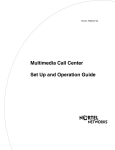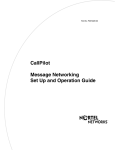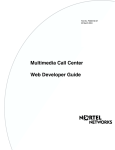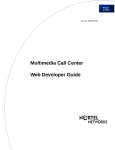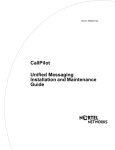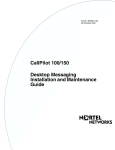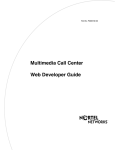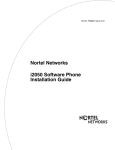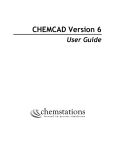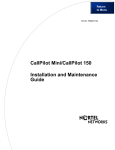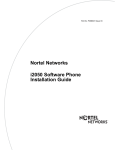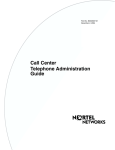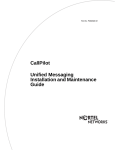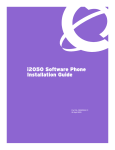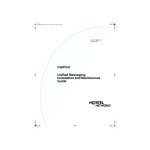Download Avaya Multimedia Call Center User's Manual
Transcript
Part No. P0935737 05 Multimedia Call Center Set Up and Operation Guide 2 Multimedia Call Center Set Up and Operation Guide Copyright © 2002 Nortel Networks All rights reserved. 2002. The information in this document is subject to change without notice. The statements, configurations, technical data, and recommendations in this document are believed to be accurate and reliable, but are presented without express or implied warranty. Users must take full responsibility for their applications of any products specified in this document. The information in this document is proprietary to Nortel Networks NA Inc. The software described in this document is furnished under a license agreement and may be used only in accordance with the terms of that license. The software license agreement is included in this document. Trademarks NORTEL NETWORKS is a trademark of Nortel Networks. Microsoft, MS, MS-DOS, Windows, and Windows NT are registered trademarks of Microsoft Corporation. All other trademarks and registered trademarks are the property of their respective owners. P0935737 05 3 Contents Chapter 1 About Multimedia Call Center . . . . . . . . . . . . . . . . . . . . . . . . . . . . . . . . . . . . . 5 Overview of Multimedia Call Center . . . . . . . . . . . . . . . . . . . . . . . . . . . . . . . . . . . . . . . 5 How Multimedia Call Center works for callers . . . . . . . . . . . . . . . . . . . . . . . . . . . . . . . . 6 The Multimedia Call Center caller interface . . . . . . . . . . . . . . . . . . . . . . . . . . . . . . 6 How Multimedia Call Center works for agents . . . . . . . . . . . . . . . . . . . . . . . . . . . . . . . . 7 The Multimedia Call Center agent interface . . . . . . . . . . . . . . . . . . . . . . . . . . . . . . 7 Multimedia Call Center call types . . . . . . . . . . . . . . . . . . . . . . . . . . . . . . . . . . . . . . . . . 8 PSTN voice and data calls . . . . . . . . . . . . . . . . . . . . . . . . . . . . . . . . . . . . . . . . . . . 8 How an agent-centric PSTN voice and data call works . . . . . . . . . . . . . . . . . . 8 Data only call . . . . . . . . . . . . . . . . . . . . . . . . . . . . . . . . . . . . . . . . . . . . . . . . . . . . . . 9 How a data only call works . . . . . . . . . . . . . . . . . . . . . . . . . . . . . . . . . . . . . . . . 9 Requirements for using CallPilot Manager to set up Multimedia Call Center . . . . . . . 10 How to get help . . . . . . . . . . . . . . . . . . . . . . . . . . . . . . . . . . . . . . . . . . . . . . . . . . . . . . 11 Chapter 2 Setting up Multimedia Call Center . . . . . . . . . . . . . . . . . . . . . . . . . . . . . . . . 13 Creating a user account for Multimedia Call Center . . . . . . . . . . . . . . . . . . . . . . . . . . 13 Enabling a Software Authorization Code . . . . . . . . . . . . . . . . . . . . . . . . . . . . . . . . . . . 14 Setting Multimedia Call Center parameters . . . . . . . . . . . . . . . . . . . . . . . . . . . . . . . . . 16 Assigning routing to Multimedia Call Center calls . . . . . . . . . . . . . . . . . . . . . . . . . . . . 19 How Multimedia Call Center calls work with Routing Tables . . . . . . . . . . . . . . . . . 19 Routing Multimedia Call Center calls using the CLID/DNIS table . . . . . . . . . . . . . . . . 20 Assigning a callback route for Multimedia Call Center . . . . . . . . . . . . . . . . . . . . . . . . 24 Configuring outdialing using PRI lines . . . . . . . . . . . . . . . . . . . . . . . . . . . . . . . . . . . . . 26 Assigning an outgoing line to a line pool . . . . . . . . . . . . . . . . . . . . . . . . . . . . . . . . . . . 33 Creating a Multimedia Call Center dial plan . . . . . . . . . . . . . . . . . . . . . . . . . . . . . . . . 35 An example of a dial plan that restricts calls based on their country . . . . . . . . . . 35 Setting the Maximum Outcalling Channels . . . . . . . . . . . . . . . . . . . . . . . . . . . . . . . . . 38 Configuring the Dialing Translation Table . . . . . . . . . . . . . . . . . . . . . . . . . . . . . . . . . . 39 Chapter 3 Multimedia Call Center agents . . . . . . . . . . . . . . . . . . . . . . . . . . . . . . . . . . . 41 Enabling Multimedia Call Center agents . . . . . . . . . . . . . . . . . . . . . . . . . . . . . . . . . . . 41 Adding Multimedia Call Center agents to Call Center . . . . . . . . . . . . . . . . . . . . . . . . . 42 Adding more than one agent . . . . . . . . . . . . . . . . . . . . . . . . . . . . . . . . . . . . . . . . . . . . 45 Accepted Call Types . . . . . . . . . . . . . . . . . . . . . . . . . . . . . . . . . . . . . . . . . . . . . . . 46 Installing Multimedia Call Center software on an agent’s computer . . . . . . . . . . . . . . Requirements for agents using Multimedia Call Center . . . . . . . . . . . . . . . . . . . . To install Multimedia Call Center software on an agent’s computer . . . . . . . . . . . Configuring Multimedia Call Center on a Windows 95 system . . . . . . . . . . . . . . . 47 47 47 48 Multimedia Call Center Set Up and Operation Guide 4 Contents Configuring an agent's server settings . . . . . . . . . . . . . . . . . . . . . . . . . . . . . . . . . . . . 49 Configuring an agent’s browser settings . . . . . . . . . . . . . . . . . . . . . . . . . . . . . . . . . . . 50 Configuring an agent’s name . . . . . . . . . . . . . . . . . . . . . . . . . . . . . . . . . . . . . . . . . . . . 51 Using Follow-me browsing . . . . . . . . . . . . . . . . . . . . . . . . . . . . . . . . . . . . . . . . . . . . . . 51 Chapter 4 Multimedia Call Center messages . . . . . . . . . . . . . . . . . . . . . . . . . . . . . . . . 53 Call setup messages . . . . . . . . . . . . . . . . . . . . . . . . . . . . . . . . . . . . . . . . . . . . . . . . . . 54 Call setup page for first-time callers . . . . . . . . . . . . . . . . . . . . . . . . . . . . . . . . . . . 54 Call setup page for subsequent callers . . . . . . . . . . . . . . . . . . . . . . . . . . . . . . . . . 55 Status and error messages . . . . . . . . . . . . . . . . . . . . . . . . . . . . . . . . . . . . . . . . . . . . . Multimedia Call Center unavailable message . . . . . . . . . . . . . . . . . . . . . . . . . . . . No agents logged on message . . . . . . . . . . . . . . . . . . . . . . . . . . . . . . . . . . . . . . . Bad calling preferences message . . . . . . . . . . . . . . . . . . . . . . . . . . . . . . . . . . . . . Choose how to connect message . . . . . . . . . . . . . . . . . . . . . . . . . . . . . . . . . . . . . Session completed message . . . . . . . . . . . . . . . . . . . . . . . . . . . . . . . . . . . . . . . . User busy message . . . . . . . . . . . . . . . . . . . . . . . . . . . . . . . . . . . . . . . . . . . . . . . Lines busy message . . . . . . . . . . . . . . . . . . . . . . . . . . . . . . . . . . . . . . . . . . . . . . . Make call failed message . . . . . . . . . . . . . . . . . . . . . . . . . . . . . . . . . . . . . . . . . . . Preferences message . . . . . . . . . . . . . . . . . . . . . . . . . . . . . . . . . . . . . . . . . . . . . . No answer message . . . . . . . . . . . . . . . . . . . . . . . . . . . . . . . . . . . . . . . . . . . . . . . Connected message . . . . . . . . . . . . . . . . . . . . . . . . . . . . . . . . . . . . . . . . . . . . . . . Call transferred message . . . . . . . . . . . . . . . . . . . . . . . . . . . . . . . . . . . . . . . . . . . 56 56 56 57 57 58 58 58 59 59 59 60 60 Web refresh message . . . . . . . . . . . . . . . . . . . . . . . . . . . . . . . . . . . . . . . . . . . . . . . . . 60 Recording Multimedia Call Center announcements . . . . . . . . . . . . . . . . . . . . . . . . . . 61 Downloading web pages and viewing web page lists . . . . . . . . . . . . . . . . . . . . . . . . . 62 Customizing web pages . . . . . . . . . . . . . . . . . . . . . . . . . . . . . . . . . . . . . . . . . . . . . . . 65 Overviews of downloading, customizing and uploading pages . . . . . . . . . . . . . . . 65 Uploading or deleting web pages . . . . . . . . . . . . . . . . . . . . . . . . . . . . . . . . . . . . . . . . 66 Creating and distributing web page lists . . . . . . . . . . . . . . . . . . . . . . . . . . . . . . . . . . . 68 Chapter 5 Viewing reports, active calls and log files . . . . . . . . . . . . . . . . . . . . . . . . . . 69 Summary call report - all calls . . . . . . . . . . . . . . . . . . . . . . . . . . . . . . . . . . . . . . . . . . . 69 Summary call report by skillset . . . . . . . . . . . . . . . . . . . . . . . . . . . . . . . . . . . . . . . . . . 70 Detail call report - all calls . . . . . . . . . . . . . . . . . . . . . . . . . . . . . . . . . . . . . . . . . . . . . . 71 Detail call report by skillset . . . . . . . . . . . . . . . . . . . . . . . . . . . . . . . . . . . . . . . . . . . . . 72 Generating Multimedia Call Center reports . . . . . . . . . . . . . . . . . . . . . . . . . . . . . . . . . 73 Monitoring active calls . . . . . . . . . . . . . . . . . . . . . . . . . . . . . . . . . . . . . . . . . . . . . . . . . 75 Viewing log files . . . . . . . . . . . . . . . . . . . . . . . . . . . . . . . . . . . . . . . . . . . . . . . . . . . . . . 77 Index . . . . . . . . . . . . . . . . . . . . . . . . . . . . . . . . . . . . . . . . . . . . . . . . . . . . . . . . 81 P0935737 05 5 Chapter 1 About Multimedia Call Center This guide assists a Call Center administrator with installing and configuring Multimedia Call Center for Nortel Networks Business Communications Manager 3.0. This guide assumes that you are familiar with using Unified Manager and CallPilot Manager. For more information, refer to the Business Communications Manager 3.0 Programming Operations Guide and the CallPilot Manager Set Up and Operations Guide. In this document the server that Multimedia Call Center is installed on is referred to as “voicebutton.<domain>” where: • <domain> is the domain name of the business, for example nortelnetworks.com • “voicebutton” is the host name of the server within the domain. The server is usually called “voicebutton”, although any unique hostname within the domain is acceptable. Overview of Multimedia Call Center With Multimedia Call Center agents and callers can have multimedia calls that include: • speaking over a Public Switched Telephone Network (PSTN) voice connection • text chatting • exchanging and viewing web pages • viewing screen captures sent by an agent Multimedia Call Center Set Up and Operation Guide 6 Chapter 1 About Multimedia Call Center How Multimedia Call Center works for callers When callers on a website click a voice button html image the “Call setup page for first-time callers” on page 54 appears for first-time callers. In the call setup page callers specify their calling preferences. Callers can access the media types based on their needs and resources. Callers with separate data and PSTN voice lines can have a PSTN voice call while they view, receive or even send web pages to agents. For information on Multimedia Call Center call types see “Multimedia Call Center call types” on page 8. After a caller specifies their preferences, the voice button call enters the Call Center. Based on the rules created by the Call Center Administrator, the request for an agent is sent to the appropriate skillset. If an agent is not immediately available, the caller can receive periodic html messages (web refresh). The Call Center Administrator programs these messages. The messages can thank callers for their interest, inform them that there are no agents currently available, and tell them that they will be connected to the first available agent. When the call is answered by an agent, the “The Multimedia Call Center caller interface” on page 6 appears in the caller’s web browser. The Multimedia Call Center caller interface The caller interface has two windows. The first window lets the caller control the progress of the call. The second window displays Multimedia Call Center messages and the web pages that an agent sends to the caller. Opens the text chat interface Opens the preferences page P0935737 05 Ends the call Displays the agent’s name Sends the web page specified in the Send Page box to the agent Chapter 1 About Multimedia Call Center 7 How Multimedia Call Center works for agents Depending on the call preferences the caller has requested in the call setup page, the agent can have a browser-only, or a voice and browser call with the caller. The agent can use follow-me browsing to show the caller a sequence of web pages. The agent can also push pages or screen captures to the caller. For a phone and browser call, the agent must answer the phone, and then the agent interface and browser window appears on the agent’s computer. For a browser-only call, the agent interface and browser window appears right away, so the agent cannot decline this type of call. The agent’s browser window shows the web page that the caller originally clicked to start the Multimedia Call Center call. The Multimedia Call Center agent interface The Multimedia Call Center agent interface has two windows. The first window lets an agent control the progress of the call. The second window displays the Multimedia Call Center web pages that the agent sends to a caller, or that a caller sends to them. Takes a screen capture of a web page, window, desktop, etc. Initiates a text chat with the caller Controls whether web pages clicked by the agent are sent to the caller Shows the url of the web page the caller clicked the voice button on Shows the name and phone number the caller specified in the Call Setup page Displays in the second window the web page the caller clicked the voice button on Opens Help Ends the browser session Blocks a caller Contains a preset list of web pages Multimedia Call Center Set Up and Operation Guide 8 Chapter 1 About Multimedia Call Center Multimedia Call Center call types Callers with a PSTN voice connection and a data connection, and callers with only a data connection can have a multimedia session with a Multimedia Call Center agent. PSTN voice and data calls PSTN voice and data calls use agent-centric routing. Agent-centric call After a caller clicks voice button the Call Center phones the caller when an agent is available. The Call Center then connects the call to the agent. How an agent-centric PSTN voice and data call works For this type of call, the caller has a separate PSTN voice and internet connection, and is not using their telephone. 1 The caller clicks the voice button icon on a web page. 2 The call setup page “Call setup page for first-time callers” on page 54 appears for first-time callers. If the caller is not a first-time caller, step 4 occurs. 3 In this example the caller enters their phone number, name and area code. The caller can specify that their call is: • • by browser only (a text chat with an agent) by phone and browser (a PSTN voice call and text chat with an agent) 4 A request for an agent is sent over the IP network to the call center. 5 While the caller is waiting web refresh html pages are displayed in their browser that correspond to the announcement they would hear if they were on a PSTN voice call. A new web page can be pushed for every Call Center announcement. 6 When a Multimedia Call Center agent becomes available, the caller's phone rings. 7 The caller answers the call. 8 The Call Center routes the PSTN voice portion of the call to the Multimedia Call Center agent. The agent's set rings and displays “www” to signify that the call is a voice button call. 9 The agent answers the call on their set and the agent’s and the caller's audio path are connected, and the agent and caller's web pages are synchronized. “The Multimedia Call Center agent interface” on page 7 appears in the agent’s browser and the “The Multimedia Call Center caller interface” on page 6 appears in the caller’s browser. 10 The agent pushes appropriate web pages to the caller. The agent can have a text chat session with the caller. Text chat is controlled by the monitor parameter. P0935737 05 Chapter 1 About Multimedia Call Center 9 Data only call For this type of call, the caller needs an Internet connection. A data only call can include text chat and pushed web pages. How a data only call works 1 The caller clicks the voice button icon on a web page. 2 While the caller is waiting web refresh html pages are displayed in their browser that correspond to the announcement they would hear if they were on a PSTN voice call. A new web page can be pushed for every Call Center announcement along with information such as the number of agents in the skillset and the number of calls in the skillset. For a full list of CGI parameters see the Multimedia Call Center Web Developer Guide. 3 When a Multimedia Call Center agent is available “The Multimedia Call Center agent interface” on page 7 appears in the agent’s browser and notifies the agent that they have a call. 4 “The Multimedia Call Center caller interface” on page 6 appears in the caller’s browser. 5 The agent pushes appropriate web pages to the caller. The agent can have a text chat session with the caller. Multimedia Call Center Set Up and Operation Guide 10 Chapter 1 About Multimedia Call Center Requirements for using CallPilot Manager to set up Multimedia Call Center You set up Multimedia Call Center using CallPilot Manager, the web-based administration tool. You access CallPilot Manager on a web browser from a computer on your network. System requirements Before you use CallPilot Manager to set up Multimedia Call Center, you must have your Business Communications Manager 3.0 system configured and Call Center installed. For how to enable a software authorization code, refer to “Enabling a Software Authorization Code” on page 14. Computer requirements The computer you use to run CallPilot Manager must have: • WinNT or Windows workstation running P133 or later CPU (or compatible) • 64 MB RAM, 10 MB disk space • Minimum screen resolution of 1024 X 768 pixels Browser requirements To use CallPilot Manager you must have: • Java Virtual Machine 5.0 (build 5.0.0.3188 or later) • either Microsoft Internet Explorer 4.0 or later, or Netscape Communicator 4.0.5 or later, but not Netscape 6.0 If you use Netscape Communicator, set these parameters: • Enable Java: on • Cached document comparison: every time • If you use Netscape Communicator version 4.77 and not all the Call Center settings shown in this guide appear in your browser, refresh the browser by clicking the View menu and clicking Reload. If you still cannot view the settings, upgrade your browser. If you use Microsoft Internet Explorer, set these parameters: • Check for newer versions: every visit to the page • Java JIT compiler enabled: on For more information about these settings, refer to your web browser online Help. For more information about using CallPilot Manager or Nortel Networks Call Center, refer to the CallPilot Manager Set Up and Operation Guide and the Nortel Networks Call Center Set Up and Operation Guide. P0935737 05 Chapter 1 About Multimedia Call Center 11 How to get help USA and Canada Authorized Distributors - Technical Support Telephone: 1-800-4NORTEL (1-800-466-7835) If you already have a PIN Code, you can enter Express Routing Code (ERC) 196#. If you do not yet have a PIN Code, or for general questions and first line support, you can enter ERC 338#. Website: http://www.nortelnetworks.com/support email: [email protected] Presales Support (CSAN) Telephone: 1-800-4NORTEL (1-800-466-7835) Use Express Routing Code (ERC) 1063# EMEA (Europe, Middle East, Africa) Technical Support Telephone: 00800 800 89009 Fax: 44-191-555-7980 email: [email protected] CALA (Caribbean & Latin America) Technical Support Telephone: 1-954-858-7777 email: [email protected] APAC (Asia Pacific) Technical Support Telephone: +61 388664627 Fax: +61 388664644 email: [email protected] Multimedia Call Center Set Up and Operation Guide 12 Chapter 1 About Multimedia Call Center P0935737 05 13 Chapter 2 Setting up Multimedia Call Center Setting up Multimedia Call Center involves: • • • • • • • • • • • Creating a user account for Multimedia Call Center Enabling a Software Authorization Code Setting Multimedia Call Center parameters Assigning routing to Multimedia Call Center calls • How Multimedia Call Center calls work with Routing Tables Routing Multimedia Call Center calls using the CLID/DNIS table Assigning a callback route for Multimedia Call Center Configuring outdialing using PRI lines Assigning an outgoing line to a line pool Creating a Multimedia Call Center dial plan • An example of a dial plan that restricts calls based on their country Setting the Maximum Outcalling Channels Configuring the Dialing Translation Table Creating a user account for Multimedia Call Center You have the option of creating user accounts that let several people have access to Multimedia Call Center settings. A user account lets users access their information, but not anyone else’s. For example, if you have a Web Developer who creates custom web pages for your business, you can create a user account for them. This gives them their own user ID and password that gives them access to certain tasks, for example, downloading and uploading web pages, and viewing web page lists. Another example is ABC Computers has weekly specials and wants to update their information weekly. You can create a user account for ABC Computers that lets anyone who has the user ID update their web pages. For information on creating user accounts, refer to the Business Communications Manager 3.0 Programming Operations Guide. Multimedia Call Center Set Up and Operation Guide 14 Chapter 2 Setting up Multimedia Call Center Enabling a Software Authorization Code You enable Multimedia Call Center by enabling the Multimedia Call Center software authorization code on the Business Communications Manager 3.0 Unified Manager. Before you enable Multimedia Call Center you must have Call Center installed on your system. To enable the Multimedia Call Center software authorization code 1 Point your web browser to the URL http://voicebutton.<domain>:6800 where <domain> is the domain name of Business Communications Manager 3.0. The Business Communications Manager 3.0 Unified Manager screen appears. 2 Click the Configure button. The Login screen appears. 3 In the User ID box type your user ID. 4 In the Password box type your password. 5 Click the Login button. The Unified Manager screen appears. 6 Click the System key. 7 Click the Licensing heading. The Licensing Setting screen appears. 8 On the Configuration menu click Add a Keycode. The Applied Keycodes screen appears. P0935737 05 Chapter 2 Setting up Multimedia Call Center 9 15 In the Keycode box type the number of the keycode you want to enable. 10 Click the Save button. 11 Do not log off Business Communications Manager 3.0. Go to “Setting Multimedia Call Center parameters” on page 16. Multimedia Call Center Set Up and Operation Guide 16 Chapter 2 Setting up Multimedia Call Center Setting Multimedia Call Center parameters You must set the system name, public host name, signature, and how long the log files are kept. To set Multimedia Call Center parameters 1 On the Unified Manager, click the Services key. 2 Click the Multimedia Call Center heading. The Summary screen appears. 3 On the Tools menu click Multimedia Call Center Admin. The Enter Network Password dialog box appears. 4 In the User Name box type your user name. 5 In the Password box type your password. P0935737 05 Chapter 2 Setting up Multimedia Call Center 17 6 Click the OK button. The System Administration page appears. 7 Under the Other Administrative Functions heading, click the View Params button. The System Parameters page appears. 8 In the System name box type the host name of your Business Communications 3.0 system. 9 In the Public host name box type the appropriate public host name for your system. Ask your network administrator how your system is set up. • If you have no firewall, or you use Business Communications Manager 3.0 as the firewall, enter the external IP address of your Business Communications Manager system. • If you use a dedicated firewall/proxy server, enter its external IP address. 10 In the Signature box enter the signature you want to use. The signature is a tag that appears on Unified Manager pages for Multimedia Call Center. The default signature is Nortel Networks Multimedia Call Center. You can change the signature. Multimedia Call Center Set Up and Operation Guide 18 Chapter 2 Setting up Multimedia Call Center 11 From the Keep log files for list box, select how long you want to keep log files. The default is 20 days. 12 Click the Update Params button. A message appears that the parameters are updated. 13 Do not log off Business Communications Manager 3.0. Go to “Assigning routing to Multimedia Call Center calls” on page 19. P0935737 05 Chapter 2 Setting up Multimedia Call Center 19 Assigning routing to Multimedia Call Center calls You must assign how Multimedia Call Center calls are routed. The standard method of assigning call routing is to specify the initial skillset in the web link that is used to initiate the call. See the Multimedia Call Center Web Developer Guide for details. You specify the skillsets to be used to the web developer, who includes this information on the customized web pages for your company. If you use Professional Call Center, you can also use the callback number information for a Multimedia Call Center Call, to move the call to another skillset or change the call’s priority within the skillset. The callback number is processed by the CLID column. Note: The skillset defined in the html tag is used unless there is an overriding rule in the CLID/DNIS table. How Multimedia Call Center calls work with Routing Tables When you set up your Call Center, you create Day and Night Routing Tables for each skillset. To route Multimedia Call Center calls effectively, you must understand how routing steps affect Multimedia Call Center calls. For example, you can set up the Night Routing Table so that when your Call Center is closed, Multimedia Call Center calls will transfer to a mailbox or another number. Before a Multimedia Call Center call is connected to an agent, these Intelligent Overflow actions disconnect the call in the caller’s browser and display a message to the caller: • • • • transfer to Skillset mailbox transfer to external or internal DN transfer to Automated Attendant transfer to Operator Before a Multimedia Call Center call is connected to an agent, these actions route the call as expected: • • • Overflow to other skillsets Move to another skillset Change priority of call For information about setting up Day and Night Routing Tables, refer to the Nortel Networks Call Center Set Up and Operation Guide. Multimedia Call Center Set Up and Operation Guide 20 Chapter 2 Setting up Multimedia Call Center Routing Multimedia Call Center calls using the CLID/DNIS table If you do not want to use a CLID/DNIS table, continue with “Assigning a callback route for Multimedia Call Center” on page 24. 1 On the Unified Manager, click the Services key. 2 Click the Voice Mail heading. The Summary screen appears. 3 On the Tools menu click CallPilot Manager Admin. The Administration Login screen appears. 4 In the Password box type your system administrator password. P0935737 05 Chapter 2 Setting up Multimedia Call Center 5 Click the Submit button. The CallPilot Manager screen appears. 6 Click the Call Center heading. 7 Click the CLID/DNIS Routing Table link. The Intelligent CLID/DNIS Routing page appears. 21 Multimedia Call Center Set Up and Operation Guide 22 Chapter 2 Setting up Multimedia Call Center 8 Click the Insert link to assign how Multimedia Call Center calls are routed. The CLID/DNIS Setup page appears. P0935737 05 Chapter 2 Setting up Multimedia Call Center 9 23 Select how you want Multimedia Call Center calls to be routed: • If you want Intelligent CLID/DNIS routing to apply to Multimedia Call Center calls, select the Voice Button check box and do not enter information in the Line or DNIS boxes. • Select the action and call priority. • Click the Submit button. The Intelligent CLID/DNIS Routing page appears. The routing rule you created appears in this table. The CLID/DNIS Routing table below shows three examples of Multimedia Call Center rules. • • • In the first Multimedia Call Center rule, Multimedia Call Center calls with a CLID or ANI of 4033 are routed to skillset 2 and given a priority of 18. In the second Multimedia Call Center rule, Multimedia Call Center calls with a CLID or ANI of 4053 change to a priority 8. In the third Multimedia Call Center rule, Multimedia Call Center calls that do not match the other rules shown in this table are routed to skillset 2 and given a priority of 4. You can use the wildcard character ( * ) for Multimedia Call Center rules. For example, if you want to program all Multimedia Call Center calls from a specific area code such as 403 to have a high priority and go to skillset 1, select Voice Button, enter 403* and select priority 1 and skillset 1. 10 Do not log off CallPilot Manager. Go to “Assigning a callback route for Multimedia Call Center” on page 24 and assign a callback route. Multimedia Call Center Set Up and Operation Guide 24 Chapter 2 Setting up Multimedia Call Center Assigning a callback route for Multimedia Call Center A callback route must be set up for Call Center to connect to the caller’s phone. You can program the callback route on a per skillset basis by programming the skillset mailbox, or on a system-wide basis by using the system administration mailbox. The callback route is determined as follows: • • • If you program a skillset to have a callback route associated with it, Multimedia Call Center uses the callback route that you have programmed. If you do not program a skillset to have a callback route, but you program the system administration mailbox to have a callback route associated with it, Multimedia Call Center uses the callback route that you have programmed. If you do not program a skillset or the system administrator mailbox to have a callback route, Multimedia Call Center uses Pool A. To assign a callback route for a skillset or the System Administrator mailbox 1 On CallPilot Manager, click the Mailbox Administration heading. The Mailbox List page appears. 2 Click the Change link for the mailbox that you want to assign a callback route to, either the system administrator mailbox or the skillset mailbox. P0935737 05 Chapter 2 Setting up Multimedia Call Center 3 25 Select an Outdial Type. If you are not sure of which outdial type to select, ask your System Administrator. • • If you select Pool, enter a number between 1 (for Pool A) and 15 (for Pool O). Make sure that this Pool has lines assigned to it. Refer to “Assigning an outgoing line to a line pool” on page 33. If your system uses PRI lines for outdialing, select Route as the outdial type. Ask your System Administrator what the PRI routing code is. If you use PRI lines, you must also: 4 a make sure the routing table is set up correctly. Refer to “Configuring outdialing using PRI lines” on page 26. b create whatever calling restrictions you need, including the routing code. Refer to “Creating a Multimedia Call Center dial plan” on page 35. c configure the Dialing Translation Table. Refer to “Configuring the Dialing Translation Table” on page 39. Do not log off. If you use PRI lines, go to “Assigning an outgoing line to a line pool” on page 33. If you use a line pool, go to “Configuring outdialing using PRI lines” on page 26. Multimedia Call Center Set Up and Operation Guide 26 Chapter 2 Setting up Multimedia Call Center Configuring outdialing using PRI lines If you use Primary Rate Interface (PRI) lines, you must configure the outdialing for your Call Center. If you don’t, go to “Assigning an outgoing line to a line pool” on page 33. 1 On Unified Manager, click the Resources key and click the Media Bay Modules key. 2 Click the Bus key for the module number of your PRI Media Bay Module. Ask your System Administrator or Installer for the module number of your PRI Media Bay Module. For information about dipswitch configuration refer to the Business Communications Manager 3.0 Installation and Maintenance Guide. 3 Click the Modules on Bus key and click the Module 1 heading. 4 Record the Low line/loop assignment that is shown. You will need this for step 7. 5 Make sure that the protocol is set to be compatible with your PRI service provider. 6 On the Configuration menu click Disable, and then click Enable. 7 Click the Services key, click the Telephony Services key, click the Lines key, click the Physical lines key, click the All physical lines key and click the key for the Low line/loop number that you recorded in step 4, (in this example Line 211). P0935737 05 Chapter 2 Setting up Multimedia Call Center 8 27 Click the Trunk/line data heading. Verify that the line type is a PRI Pool. Record the Pool letter. You need this for the “Use Pool” value in the routing table. Multimedia Call Center Set Up and Operation Guide 28 Chapter 2 Setting up Multimedia Call Center 9 Scroll down to the Call routing key and click it. Click the Routes heading and click the Add button. The BCM Dialog Box appears. 10 In the Route box, type a route number. In this example route 002 is shown. 11 Click the Save button. P0935737 05 Chapter 2 Setting up Multimedia Call Center 29 12 Click the Routes key and select Route you created. From the Use pool list box select Pool PRI-A. From the DN type list box select Public. Multimedia Call Center Set Up and Operation Guide 30 Chapter 2 Setting up Multimedia Call Center 13 To configure destination codes, click the Destination codes heading and click the Add button. The BCM Dialog box appears. 14 In the Destination code box type the destination code you want to use. In this example 8A is shown. (A represents any). This means that any dialed number that starts with 8 uses PRI-A, that is, routing code 8 uses Pool PRI-A. 15 Click the Destination Codes key and click the key for the destination code you created. Click the Schedules key and click the Normal heading. 16 In the Use route box change the route number to 002. 17 Configure the absorb length. From the Absorb length list box select an absorb length. Set the absorb length so that the routing code is not actually dialed. P0935737 05 Chapter 2 Setting up Multimedia Call Center 31 In this example, 8A is the destination code, with an absorb length of 1. This means that the 8 is absorbed, and only the digits after it are dialed out on the PRI line. 18 Now configure the public DN length. This is the length of digits after the prefix that agents can dial. Click the General settings key, click the Dialing plan key, click the Public Network Multimedia Call Center Set Up and Operation Guide 32 Chapter 2 Setting up Multimedia Call Center key, click the Public DN lengths key and from the list select the prefix that selects PRI for outdialing. In this example the prefix is the number 8 and the DN length is 10 digits. 19 Log off Unified Manager. Do not Assign an outgoing line to a line pool. Go to “Creating a Multimedia Call Center dial plan” on page 35. P0935737 05 Chapter 2 Setting up Multimedia Call Center 33 Assigning an outgoing line to a line pool You must assign an outgoing line to a line pool so that Multimedia Call Center accepts callback calls. In this example, a line is assigned to Pool A. You do not need to do this procedure if you use PRI lines. To assign an outgoing line to a line pool 1 On a telset, enter Feature 985 to display the Voicemail DN. 2 On the Unified Manager screen, click the Services key. 3 Click the Telephony Services key. 4 Click the System DNs key. 5 Click the All System DNs key. 6 Click the key for the Voicemail DN. 7 Click the Line access heading. 8 From the Prime Line list box select Pool A. 9 Click the General Settings key. 10 Click the Access Codes key. 11 Click the Line pool codes key. 12 Click the Pool A heading. The Pool A screen appears. Multimedia Call Center Set Up and Operation Guide 34 Chapter 2 Setting up Multimedia Call Center 13 Make sure that Access code is set to 9. 14 Click the Lines key and click the key for the number of the line you want to use for outdialing. 15 Click the Trunk/line data heading. 16 In the Line type list box make sure that Pool A is selected. Do not log off. Go to “Creating a Multimedia Call Center dial plan” on page 35. P0935737 05 Chapter 2 Setting up Multimedia Call Center 35 Creating a Multimedia Call Center dial plan You can create a callback dial plan that restricts Multimedia Call Center from calling certain numbers. When you create a dial plan you add restrictions to the DNs that Business Communications Manager 3.0 uses for callback. This limits where MMCC will accept calls from, for example you can create a restriction that limits calls to local calls from your service area. You can add restrictions to skillset and the Voicemail DNs. You can display DNs by entering Feature 985 on a set. Note: If you add a restriction to the Voicemail DN you also restrict all outcalling calls, including external transfers from CCR Trees, Off-premise Message Notification and Outbound Transfers. An example of a dial plan that restricts calls based on their country Bridgestone computers sells computers in the United States and Canada, and has different information for prices and shipping depending on the country. The Call Center administrator sets up restrictions for the U.S. and Canada skillsets. When a caller in the U.S. clicks the voice button and enters their phone number, the restrictions for the US skillset recognize the caller’s U.S. area code, and calls back telephone numbers within the US. To add a restriction to the Business Communications Manager system 1 Click the Services key. 2 Click the Telephony Services key. 3 Click the Restriction filters key. 4 Click the key for the filter you want to add a restriction to. Multimedia Call Center Set Up and Operation Guide 36 Chapter 2 Setting up Multimedia Call Center 5 Right-click the Restrictions heading and click Add. The Add Restrictions dialog box appears. 6 In the Digits box, type the digits you want to restrict. If your outdial type is Route, enter the routing code before you add the digits you want to restrict. For example, if your routing code is 8 and you want to restrict numbers that begin with 403, enter 8403. 7 Click the Save button. 8 Click the Services key. 9 Click the Telephony Services key. 10 Click the System DNs key. 11 Click the All system DNs key. 12 Click the key for the Voice Mail DN or the DN of the skillset you want to add a restriction to. 13 Click the Restrictions key. 14 Click the Set Restrictions key. 15 Click the Schedules key. 16 Click the Normal heading. P0935737 05 Chapter 2 Setting up Multimedia Call Center 37 17 In the Use filter box type the filter number. The default restriction filter is 00. For more information on programming dialing plans and filters refer to the “Configuring Business Communications Manager 3.0 Services" section of the Business Communications Manager 3.0 Programming Operations Guide. 18 Do not log off. Go to “Setting the Maximum Outcalling Channels” on page 38. Multimedia Call Center Set Up and Operation Guide 38 Chapter 2 Setting up Multimedia Call Center Setting the Maximum Outcalling Channels When you install Multimedia Call Center on your system, set the Maximum Outcalling Channels to a value higher than 1. The default number of voice channels assigned for outcalling is 1. Also, to ensure that the Outcalling Channels do not consume all the available voice channels, set the minimum number of voice ports to a number higher than the Outcalling Channels. For information on how to change the minimum number of voice ports refer to the MSC Configuration chapter of the Business Communications Manager 3.0 Programming Operations Guide. If you do not set the Maximum Outcalling Channels to higher than one, callers see the “Lines busy message” on page 58. 1 On CallPilot Manager, click the Configuration heading. 2 Click the System Properties link. The System Properties page appears. 3 In the Max Outcalling Channels box type a value higher than 1. 4 Click the Submit button. 5 You can log off CallPilot Manager and return to Unified Manager. Do not log off Unified Manager. Go to “Configuring the Dialing Translation Table” on page 39. P0935737 05 Chapter 2 Setting up Multimedia Call Center 39 Configuring the Dialing Translation Table If your outdialing type is route, configure the Dialing Translation Table to add your routing prefix to the callback numbers. 1 Click the Services key and click the Voice Mail heading. The CallPilot Manager screen appears. 2 On the Tools menu click Call Pilot Manager Admin. The CallPilot Manager Administration Login page appears. 3 In the Password box enter the CallPilot Manager password and click the Submit button. 4 Set up Dialing Translation Tables so that when Call Center dials a callback number, it first dials the routing code to access the PRI pool. Call Center can use callers’ phone numbers as entered. Click the Configuration heading and click the Dialing Translation Table link. The Dialing Translation Table page appears. Multimedia Call Center Set Up and Operation Guide 40 Chapter 2 Setting up Multimedia Call Center 5 Click the Add button. The Dialing Translation Setup page appears. 6 In the Input Value box enter the number you want to translate. In the Output Value box enter what you want to translate the number to. In this example, the number 4 is translated to 84. This means that when a Multimedia Call Center callers enters a number that starts with 4, Call Center automatically adds the prefix 8. 7 Click the Submit button. P0935737 05 41 Chapter 3 Multimedia Call Center agents Setting up Multimedia Call Center agents involves: • • • • • • Enabling Multimedia Call Center agents Adding Multimedia Call Center agents to Call Center Adding more than one agent Installing Multimedia Call Center software on an agent’s computer Configuring an agent's server settings Configuring an agent’s name Enabling Multimedia Call Center agents With the Nortel Networks Multimedia Call Center Software Authorization Code you can enable all your Call Center agents as Multimedia Call Center agents. If you need more agents, you can purchase additional agent Software Authorization Codes that enable an additional 1, 4, 8, 16 or 32 agents. To enable Multimedia Call Center agents 1 Follow the steps in “Enabling a Software Authorization Code” on page 14 to apply the Call Center Agent Software Authorization Code for the number of agents you want to enable. 2 Do not log off Business Communications Manager 3.0. Follow the steps in “Adding Multimedia Call Center agents to Call Center” on page 42 to add Multimedia Call Center agents to Call Center. Multimedia Call Center Set Up and Operation Guide 42 Chapter 3 Multimedia Call Center agents Adding Multimedia Call Center agents to Call Center To add Multimedia Call Center agents to Call Center 1 On the Unified Manager, click the Services key. 2 Click the Voice Mail heading. The Voice Mail screen appears. 3 On the Tools menu click CallPilot Manager Admin. The Administration Login screen appears. 4 In the Password box type the system administrator password. 5 Click the Submit button. The CallPilot Manager Main page appears. P0935737 05 Chapter 3 Multimedia Call Center agents 6 Click the Call Center heading. 7 Click the Agent List link. The Agent List page appears. 43 Multimedia Call Center Set Up and Operation Guide 44 Chapter 3 Multimedia Call Center agents 8 Add a new Multimedia Call Center agent to the Call Center or change a Call Center agent’s settings: • • 9 If the agent has been added to Call Center and you want to enable them as a Multimedia Call Center agent, click the Change link for the agent. The Change Agent page appears. If the agent has not been added to Call Center and you want to add a new agent as a Multimedia Call Center agent, click the Add button. The Add Agent page appears. From the Accepted Call Types list box select whether the agent takes voice button calls or Call Center and voice button calls. See “Accepted Call Types” on page 46 more information. • • Select Voice Button if you want the agent to take voice button calls. Select Both if you want the agent to take voice button and Call Center calls. 10 Click the Submit button. P0935737 05 Chapter 3 Multimedia Call Center agents 45 Adding more than one agent You can save time by adding more than one agent at a time. When you add multiple agents, the agents have the default agent name and parameters. To add more than one agent 1 Start CallPilot Manager. 2 Click the Call Center heading. 3 Click the Add Many Agents link. The Add Many Agents page appears. 4 In the From box type the lowest agent ID number of the agents you want to create. 5 In the To box type the highest agent ID number of the agents you want to create. The Agent ID numbers you enter must be between 1 and 250. 6 Select the Supervisor check box if you want the agents to have Supervisor status. 7 Select the Automatic Answer check box if you want calls to be force-delivered to the agents. 8 From the Missed Call Option list box select Make Not Ready (Return to Skillset) or Automatic Logout. 9 From the Accepted Call Types list box select whether the agent takes voice button calls or Call Center and voice button calls. See “Accepted Call Types” on page 46 more information. • • Select Voice Button if you want the agent to take voice button calls. Select Both if you want the agent to take voice button and Call Center calls. 10 Click the Submit button. Note: Any agents who have an agent ID number that is between the numbers you enter in the From and To boxes are not changed. These agents are not included in the number of agents added. Multimedia Call Center Set Up and Operation Guide 46 Chapter 3 Multimedia Call Center agents Accepted Call Types The Accepted Call Types parameter determines what type of calls are routed to an agent. This parameter also determines whether an agent must log onto a telephone, Multimedia Call Center or both. This table shows what capabilities agents have depending on their Accepted Call Types and what they are logged onto. Type of calls you can receive Voice Multimedia Call Center Both P0935737 05 Are you logged onto a telephone? Are you logged Can you have onto Multimedia voice calls? Call Center? Can you have phone and browser Multimedia Call Center calls? Can you have browser only Multimedia Call Center calls? No Not permitted No - - YES Not permitted YES - - No No - No No No YES - No YES YES No - No No YES YES - YES YES No No No No No No YES No No No YES No No No No YES YES YES YES YES Chapter 3 Multimedia Call Center agents 47 Installing Multimedia Call Center software on an agent’s computer You must install and configure the Multimedia Call Center software on the computer of each Multimedia Call Center agent. Requirements for agents using Multimedia Call Center To use Multimedia Call Center, agents must have: • • • • • • Internet Explorer 5.5 with SP 2, or a later version of Internet Explorer any of these operating systems: Windows 95B, Windows 98SE, Windows NT4 SP5 (or later), Windows 2000, Windows ME or Windows XP a Pentium II processor at 233MHz, minimum (Pentium III at 500MHz or higher recommended) 64 MB of RAM, minimum (128 MB or higher recommended) 30 MB of free hard drive space a network card and an Internet connection To install Multimedia Call Center software on an agent’s computer 1 On the agent’s computer, point the web browser to the URL http://voicebutton.<domain>:6800 where <domain> is the domain name of Business Communications Manager 3.0. The Business Communications Manager 3.0 Unified Manager screen appears. 2 Click the Install Clients button. The Download Client Applications page appears. Multimedia Call Center Set Up and Operation Guide 48 Chapter 3 Multimedia Call Center agents 3 In the left frame, under the Call Center Applications heading, click the Multimedia Call Center link. Note: You must install Java Runtime Environment (JRE) before you download Multimedia Call Center to the agent’s computer. 4 Click the http://javasoft.com link and download JRE. The File Download dialog box appears. 5 Click the Save this program to disk option and then click the OK button. The Save As dialog box appears. 6 Navigate to where you want to download the file to and click the Save button. 7 Locate the downloaded file and double-click the icon to install Java Runtime Environment. 8 On the Download Desktop Applications page, click the Download Multimedia Call Center button. The File Download dialog box appears. 9 Select the option to save the program or run it, and then click the OK button. The Save As dialog box appears. 10 Navigate to where you want to download the file to and click the Save button. 11 Locate the downloaded file and double-click it to unzip it and install the Agent Notification software on the agent’s computer. We recommend you install the software in C:\Program Files\Nortel Networks\Voice Button Agent Notification. Configuring Multimedia Call Center on a Windows 95 system Download this patch for each Multimedia Call Center agent who uses the Windows 95 operating system on their computer. This patch upgrades the agent’s WinSock32 to version 4.10.1656. To download the patch 1 On the agent’s computer point the web browser to the Microsoft website at http://www.microsoft.com 2 Search for Windows Socket 2 Update. 3 Download the patch and follow the installation instructions. P0935737 05 Chapter 3 Multimedia Call Center agents 49 Configuring an agent's server settings To configure an agent’s server settings 1 To start the Multimedia Call Center software on the agent’s computer, click the Start button, point to Programs, point to Nortel Networks, point to Multimedia Call Center and click Agent Notification. The Agent Login/Logout dialog box appears. 2 On the Options menu click Server Setup. The Server Setup dialog box appears. 3 In the Server IP box type the IP address of the voice button server. 4 In the Server Port box type the port number. The default port number is 6800. 5 Click the OK button. Multimedia Call Center Set Up and Operation Guide 50 Chapter 3 Multimedia Call Center agents Configuring an agent’s browser settings 1 On the agent’s computer, start Internet Explorer. 2 On the Tools menu click Internet Options. The Internet Options dialog box appears. 3 Click the Advanced tab. 4 Under the Java (Sun) option, clear the Use Java setting. P0935737 05 Chapter 3 Multimedia Call Center agents 51 Configuring an agent’s name Either you or the agent can enter the agent name that is displayed to callers. 1 To start the Multimedia Call Center software on the agent’s computer, click the Start button, point to Programs, point to Nortel Networks, point to Multimedia Call Center and click Agent Notification. The Agent Login/Logout dialog box appears. 2 On the Options menu click Agent Name. The Agent Preferences dialog box appears. 3 In the Agent Name box type the agent name that will be displayed to callers. 4 Click the OK button. Using Follow-me browsing Follow-me browsing does not work with embedded Flash animations. If an agents clicks a Flash button, the image that is sent to the agent is not displayed to the caller. Tell agents that if the page they are sending to the caller contains Flash animations, they must tell the caller to display the page by, for example, clicking the Next button, or telling them what to click on the page to display the next page. Multimedia Call Center Set Up and Operation Guide 52 Chapter 3 Multimedia Call Center agents P0935737 05 53 Chapter 4 Multimedia Call Center messages Multimedia Call Center messages are messages that are sent from a business’ web site to callers, who are customers, contacts, or surfers that have contacted the business. These messages assist customers in making contact with the business, give customers choices in the type of media they use to contact the business, and provide updates about the progress of their call. You or your web developer can: • • • customize the default Multimedia Call Center message templates create lists of web pages that Multimedia Call Center agents push to callers create interfaces, which are sets of web pages specific to topics, such as sales and service department, or languages, such as French, Spanish and German For information about: • default Multimedia Call Center messages see: • “Call setup messages” on page 54 • “Status and error messages” on page 56 • “Web refresh message” on page 60 • downloading message templates see “Downloading web pages and viewing web page lists” on page 62 • customizing messages see “Customizing web pages” on page 65 • uploading web pages see “Uploading or deleting web pages” on page 66 • creating and distributing lists of web pages see “Creating and distributing web page lists” on page 68 • creating custom interfaces refer to the Multimedia Call Center Web Developer Guide Multimedia Call Center Set Up and Operation Guide 54 Chapter 4 Multimedia Call Center messages Call setup messages “Call setup page for first-time callers” on page 54 shows the interface for first-time callers. “Call setup page for subsequent callers” on page 55 shows the interface for subsequent callers. Call setup page for first-time callers First-time callers see this html form when they click the voice button icon on an html page.Subsequent callers see this page if the voicebutton icon or Multimedia Call Center link includes the do_setup=on parameter. For information about the do_setup=on parameter refer to “Call preferences - the setup command” in the Multimedia Call Center Web Developer Guide. CallSetup.html P0935737 05 Chapter 4 Multimedia Call Center messages 55 Call setup page for subsequent callers Callers see this html form if they click the preferences link. Callers can click the preferences link from the applet interface or a web page. Preferences.html Multimedia Call Center Set Up and Operation Guide 56 Chapter 4 Multimedia Call Center messages Status and error messages During a call, a caller can see one or more of these status and error messages. Multimedia Call Center displays these messages by creating an instance of the HTML template file called MSG.html. Multimedia Call Center unavailable message Callers see this message if they click the voice button while Business Communications Manager 3.0 is not operational. MSG.html No agents logged on message Callers see this message if there are no Multimedia Call Center agents logged on. MSG.html P0935737 05 Chapter 4 Multimedia Call Center messages 57 Bad calling preferences message Callers see this message if the phone number they enter in the call setup page is improperly formatted, or if Multimedia Call Center does not provide service to their calling area. MSG.html Choose how to connect message Callers see this message if they do not specify their connection preferences in the call setup page. MSG.html Multimedia Call Center Set Up and Operation Guide 58 Chapter 4 Multimedia Call Center messages Session completed message Callers see this message after they click the Hangup button on the caller interface. MSG.html User busy message Callers see this message if their call cannot be completed because their phone line is busy. MSG.html Lines busy message Callers see this message if their call cannot be completed because Business Communications Manager 3.0 has no available phone lines. Set the Maximum Outcalling Channels to more than one so that phone lines are available. For more information refer to “How Multimedia Call Center calls work with Routing Tables” on page 19. MSG.html P0935737 05 Chapter 4 Multimedia Call Center messages 59 Make call failed message Callers see this message if their call cannot be connected because there is a problem with the voice button server. MSG.html Preferences message Callers see this message after they enter their calling preferences in the call setup page. MSG.html No answer message Callers see this message if they do not answer their phone. MSG.html Multimedia Call Center Set Up and Operation Guide 60 Chapter 4 Multimedia Call Center messages Connected message Callers see this message when they connect to an agent. MSG.html Call transferred message Callers see this message when Multimedia Call Center or an agent transfers the voice call. MSG.html Web refresh message Callers see this message while they are waiting for a Multimedia Call Center agent to become available. You or your web developer can create variations of this message to assure callers that their call is important, and all agents are still busy. REFRESH.html P0935737 05 Chapter 4 Multimedia Call Center messages 61 Recording Multimedia Call Center announcements When you record announcements for Multimedia Call Center, record announcements that correspond to the web refresh messages. This way, callers hear a voice announcement while they view a related message. You record Call Center messages using CallPilot Manager. For information on recording Call Center announcements see the Call Center Set Up and Operation Guide. Multimedia Call Center Set Up and Operation Guide 62 Chapter 4 Multimedia Call Center messages Downloading web pages and viewing web page lists If you want to customize a Multimedia Call Center page, download it to your computer, customize it, and then upload it to Business Communications Manager 3.0. You can also view the lists of Multimedia Call Center files that are on your system. To download web pages or view lists of pages 1 Point your web browser to the URL http://voicebutton.<domain>:6800 where <domain> is the domain name of Business Communications Manager 3.0. The Business Communications Manager 3.0 Unified Manager screen appears. 2 Click the Configure button. The Login screen appears. 3 In the User ID box type your user ID. 4 In the Password box type your password. 5 Click the Login button. The Unified Manager screen appears. 6 Click the Services key. 7 Click the Multimedia Call Center heading. 8 On the Tools menu click Multimedia Call Center Admin. The Enter Network Password dialog box appears. 9 In the User Name box type your user name. P0935737 05 Chapter 4 Multimedia Call Center messages 63 10 In the Password box type your password. 11 Click the OK button. The System Administration page appears. Multimedia Call Center Set Up and Operation Guide 64 Chapter 4 Multimedia Call Center messages 12 Under the Customize heading, click the View/Download Files button to generate a list of the files. The list appears in a new browser page. The default sub-folder contains the set of default web page templates and text substitutions. Other sub-folders are created when you upload customized web pages. 13 To view a list of web pages, click the link for the list you want to view or to download the default web pages if you want to customize Multimedia Call Center web pages, click the default link. In this example, we clicked the default link. The list of default Multimedia Call Center web pages appears. 14 To download a file, right-click the link, click Save As and save the file to your computer. You can change the filename if you want to. P0935737 05 Chapter 4 Multimedia Call Center messages 65 Customizing web pages You or your web developer can customize web pages and upload them to Business Communications Manager 3.0. You can customize the default Multimedia Call Center web pages or create your own. Note: Do not directly edit web pages. Do not change the location of the Multimedia Call Center default files on Business Communications Manager 3.0. To customize web pages 1 Download the web page or web page list you want to customize to your computer. Refer to “Downloading web pages and viewing web page lists” on page 62. 2 Customize the file or list of files. 3 Upload the customized files to Business Communications Manager 3.0 using the procedure in “Uploading or deleting web pages” on page 66. Overviews of downloading, customizing and uploading pages An overview of customizing an MSG.html file for the ABC Computer Company 1 Download the MSG.html template from Business Communications Manager 3.0 to your desktop. Refer to “Downloading web pages and viewing web page lists” on page 62. 2 Customize the MSG.html file. 3 Save the new customized file in your local directory. Save the new file with a new name, such as abc_msg.html. 4 Log on to Business Communications Manager 3.0 using the ABC Computer Company User ID and password. For more information about user accounts see “Creating a user account for Multimedia Call Center” on page 13. 5 Upload the file. Refer to “Uploading or deleting web pages” on page 66. An overview of uploading Spanish-language status and error messages 1 Download the msg.html and msg.txt template files from Business Communications Manager to your desktop and customize them. Refer to “Downloading web pages and viewing web page lists” on page 62. 2 Upload the files using the procedure in “Uploading or deleting web pages” on page 66: • • • • In the Interface name text box type spanish. In the Remote file name text box type msg.html. In the Local file text box type the local path to the customized msg.html file, or use the Browse button to help you locate the file on your desktop. Click the Add File button. Multimedia Call Center Set Up and Operation Guide 66 Chapter 4 Multimedia Call Center messages Uploading or deleting web pages After you customize Multimedia Call Center web pages, use this procedure to upload them to Business Communications Manager 3.0. You can also use this procedure to delete any customized files that are outdated, misnamed, or misfiled. To upload or delete customized files 1 Point your web browser to the URL http://voicebutton.<domain>:6800 where <domain> is the domain name of Business Communications Manager 3.0. The Business Communications Manager 3.0 Unified Manager screen appears. 2 Click the Configure button. The Login screen appears. 3 In the User ID box type your user ID. 4 In the Password box type your password. 5 Click the Login button. The Unified Manager screen appears. 6 Click the Services key. 7 Click the Multimedia Call Center heading. 8 On the Tools menu click Multimedia Call Center Admin. The Enter Network Password dialog box appears. 9 In the User Name box type your user name. 10 In the Password box type your password. 11 Click the OK button. The System Administration page appears. P0935737 05 Chapter 4 Multimedia Call Center messages 67 12 To upload files: a In the Interface name box type the folder name you want to save the file in. Either enter the name of an existing folder, or type a new name. If you type a new name, a new folder is created. The folder name is used as the interface parameter in links from your web site to Multimedia Call Center. For more information on creating web links see chapter 3, “Integrating Multimedia Call Center with a website” in the Multimedia Call Center Web Developer Guide. b In the Remote File name box enter the name of the file, for example, LaunchMonitor.html. c Click the Browse button and browse to the location of the file you customized, for example, ABCLaunch.html, or enter the path name of the file in the Local file box. d Click the Add File button. To delete files: a In the Interface name box type the folder name you want to delete the file from. b In the Remote File name box enter the name of the file, for example, LaunchMonitor.html. c Click the Delete File button. To upload graphics such as .gifs or .jpegs, or other media such as .wav files or animated gifs: a In the Interface name box type media. b In the Remote file name box enter the name that you want to save the file as. c Click the Browse button and browse to the location of the file, or enter the path name of the file in the Local File box. d Press the Add File button and check in the file list that the file is uploaded. When you include the uploaded media on a web page, use the relative path “/ivb-media” to refer to uploaded media files. For example, if you upload the file “logo.jpg” to the media interface, in a custom HTML files reference the file by including a tag such as <IMG SRC="/ivb-media/logo.jpg" ...>. Multimedia Call Center Set Up and Operation Guide 68 Chapter 4 Multimedia Call Center messages Creating and distributing web page lists You or your web developer can create bookmarked lists of web pages that agents can push to callers. After you create a web page list, export it in a shared directory on your network and notify the Multimedia Call Center agents to import the list. Note: You must use Internet Explorer for the web page lists you create and distribute. Netscape is not supported. To create a list of web pages 1 In your browser, create a folder for the new list of web pages. Create a folder name that is easy to identify. 2 Browse to the pages you want to bookmark. 3 Bookmark each page, and save each bookmark in the folder you created. 4 To start the Import/Export Wizard, on the File menu click Import and Export. 5 Save the folder you created to a network drive. 6 Send an email to the agents that they should import the new folder into their Favorites. In your email tell the Multimedia Call Center agents where the web page list is located on the network. Be sure to include the location of the folder in your message. You can set up an address list of agents so you can notify all the agents with one email. Whenever you create or update a web page list, notify the agents to copy the list to their computer. P0935737 05 69 Chapter 5 Viewing reports, active calls and log files There are four reports you can generate that show the Multimedia Call Center activity on Business Communications Manager 3.0: Report Contains Summary call report - all calls a summary of call statistics over a specified time Summary call report by skillset a summary of call statistics for all skillsets over a specified time Detail call report - all calls a detailed list of all calls made over a specified time Detail call report by skillset a detailed list of all calls made by all skillsets over a specified time Note: Active calls and calls waiting in skillsets are not included in reports. To see all calls, including Multimedia Call Center calls waiting in skillsets, press Feature 909 on a Business Communications Series terminal. Browser Only calls are not shown when you use Feature 909. Summary call report - all calls The Summary call report for all calls shows: • • • • • total number of Multimedia Call Center calls completed total number of text calls completed total number of calls ("transactions") total time of all calls average time per call Multimedia Call Center Set Up and Operation Guide 70 Chapter 5 Viewing reports, active calls and log files An example of a Summary call report for all calls Summary call report by skillset The Summary call report by skillset shows the information in the Summary call report for all calls, and the information by skillset. An example of a Summary call report by skillset P0935737 05 Chapter 5 Viewing reports, active calls and log files 71 Detail call report - all calls The Detail call report for all calls shows the information in the Summary call report for all calls, and a detailed list of each call completed during the time period of the report. For each call, the report shows: • • • • • Time - the time and date the call started Duration - the duration of the call Request from - the caller's phone number Received by - the agent's phone number Group - the skillset An example of a Detail call report for all calls Multimedia Call Center Set Up and Operation Guide 72 Chapter 5 Viewing reports, active calls and log files Detail call report by skillset The Detail call report by skillset shows the information in the Detail call report for all calls and summarizes the information by skillset. Example of a Detail call report by skillset P0935737 05 Chapter 5 Viewing reports, active calls and log files 73 Generating Multimedia Call Center reports Note: Generating reports can put an additional load on Business Communications Manager 3.0. Avoid generating reports during periods of peak activity. If possible, generate reports after hours. To generate a Multimedia Call Center report 1 Point your web browser to the URL http://voicebutton.<domain>:6800 where <domain> is the domain name of Business Communications Manager 3.0. The Business Communications Manager 3.0 Unified Manager screen appears. 2 Click the Configure button. The Login screen appears. 3 In the User ID box type your user ID. 4 In the Password box type your password. 5 Click the Login button. The Unified Manager screen appears. 6 Click the Services key. 7 Click the Multimedia Call Center heading. The Summary screen appears. Multimedia Call Center Set Up and Operation Guide 74 Chapter 5 Viewing reports, active calls and log files 8 On the Tools menu click Multimedia Call Center Admin. The Enter Network Password dialog box appears. 9 In the User Name box type your user name. 10 In the Password box type your password. 11 Click the OK button. The System Administration page appears. 12 Under the Reporting heading, select the type of report you want to generate: • Summary Call Report - All Calls • Detail Call Report - All Calls • Summary Call Report By Skillset • Detail Call Report By Skillset 13 From the View Report list box, select the time period for the report: • today - includes calls completed on the current day up to the time the report is generated • current reporting period - includes calls made since the last time the reporting period was archived 14 Press the View Report button to generate the report. 15 If you want to archive the file used to generate the reports, click the Archive Reporting button. A message appears that asks you to confirm your request. Click the OK button. The report is stored in BCM/Program Files/Nortel Networks/Voice Button/System. P0935737 05 Chapter 5 Viewing reports, active calls and log files 75 Monitoring active calls You can monitor active Multimedia Call Center calls. To monitor active calls 1 Point your web browser to the URL http://voicebutton.<domain>:6800 where <domain> is the domain name of Business Communications Manager 3.0. The Business Communications Manager 3.0 Unified Manager screen appears. 2 Click the Configure button. The Login screen appears. 3 In the User ID box type your user ID. 4 In the Password box type your password. 5 Click the Login button. The Unified Manager screen appears. 6 Click the Services key. 7 Click the Multimedia Call Center heading. The Summary screen appears. 8 On the Tools menu click Multimedia Call Center Admin. The Enter Network Password dialog box appears. 9 In the User Name box type your user name. Multimedia Call Center Set Up and Operation Guide 76 Chapter 5 Viewing reports, active calls and log files 10 In the Password box type your password. 11 Click the OK button. The System Administration page appears. 12 Under the Reporting heading, click the Active Calls button. A report of all the currently active Multimedia Call Center calls appears in a separate window. P0935737 05 Chapter 5 Viewing reports, active calls and log files 77 Viewing log files Log files are automatically generated daily by Multimedia Call Center. You can use log files to diagnose system problems. The log files include all activity that occurs with its CGI interface and its telephony server. On days with no Multimedia Call Center activity, CGI log files are not generated, and blank mslog and vwlog files are generated. Multimedia Call Center Log files are generated in C:\Program Files\Nortel Networks\Voice Button\logs. The logs are named: • • • cgilog_YYYY_MM_DD.txt: log file of CGI activity nslog_YYYY_MM_DD.txt: log file of NSACD service vwlog_YYYY_MM_DD.txt: log file of VBServer service where YYYY is a 4-digit year MM is a 1- or 2-digit month DD is a 1- or 2-digit day The Call Center log file is generated in D:\st\stlog.out. To view a log file 1 Point your web browser to the URL http://voicebutton.<domain>:6800 where <domain> is the domain name of Business Communications Manager 3.0. The Business Communications Manager 3.0 Unified Manager screen appears. 2 Click the Configure button. The Login screen appears. 3 In the User ID box type your user ID. 4 In the Password box type your password. 5 Click the Login button. The Unified Manager screen appears. 6 Click the Services key. Multimedia Call Center Set Up and Operation Guide 78 Chapter 5 Viewing reports, active calls and log files 7 Click the Multimedia Call Center heading. The Summary screen appears. 8 On the Tools menu click Multimedia Call Center Admin. The Enter Network Password dialog box appears. 9 In the User Name box type your user name. 10 In the Password box type your password. 11 Click the OK button. The System Administration page appears. P0935737 05 Chapter 5 Viewing reports, active calls and log files 79 12 Click the Examine Logs button. The Examine Logs screen appears. 13 Select the log file you want to view: • Click the view log button to view the log you select. • Click the analyze log button to see a summary for the log you select. 14 If you want to archive the log and reset the statistics, click the archive reporting button. A message appears that asks you to confirm the reset. 15 Click the OK button. Multimedia Call Center Set Up and Operation Guide 80 Chapter 5 Viewing reports, active calls and log files P0935737 05 81 Index A about 35 example 35 Adding multiple agents to Call Center 45 Agent Accepted Call Types 46 adding multiple agents to Call Center 45 name 51 server settings 49 software, installing 47 F Agent browser settings 50 Flash animations 51 Agents adding to Call Center 42 enabling 41 Follow-me browsing 51 Announcements Call Center 61 recording 61 Help, support and technical 11 B IP address 49 Bookmarks creating and distributing 68 exporting 68 J Browser settings, agent 50 L Busy phone line message 58 Lines busy message 58 C Lines, routing Multimedia Call Center calls 20 Call failed message 59 Call preferences incorrectly formatted message 57 Call types agent-centric 8, 19 caller-centric 8 voice and data 8 Caller preferences page 55 Caller preferences, Call setup page 6 CallPilot Manager browser requirements 10 computer requirements 10 system requirements 10 Calls, routing 20 CallSetup message 54 Choose how to connect message 57 Connected message 60 D Detail call report (all calls) 71 Detail call report (by skillset) 72 Dial plan Favorites creating and distributing 68 exporting 68 First-time callers message 54 H I Java settings 50 Log files about 77 viewing 77 M Messages announcements 61 busy phone line 58 call failed 59 call preferences incorrectly formatted 57 Call Setup page 54 call transferred 60 CallSetup 54 choose how to connect 57 connected 60 customizing 65 deleting 68 downloading 62 first-time callers 54 lines busy 58 Multimedia Call Center unavailable 56 no agents logged on 56 no answer 59 no phone lines available 58 Multimedia Call Center Set Up and Operation Guide 82 Index Preferences 55 preferences saved 59 refresh 60 server down 56, 59 session completed 58 subsequent callers 55 uploading 66 user busy 58 viewing 62 web refresh 60 Multimedia Call Center agent 41, 42, 49 agent interface 7 agent name 51 agent software 47 Call setup page 6 call types 8 caller interface 6 installing 14 IP address 49 overview 5 port address 49 reports Detail call report (all calls) 71 Detail call report (by skillset) 72 Summary call report (all calls) 69 Summary call report (by skillset) 70 reports, generating 73 setting up 13 software authorization code 14 Multimedia Call Center calls assigning outgoing line 33 CLID/DNIS routing 19 enabling call-back 33 Intelligent Overflow rules 19 routing 19 Multimedia Call Center unavailable message 56 N No agents logged on message 56 No answer message 59 No phone lines available message 58 O Preferences, caller 55 PRI lines 26 R Refresh message 60 Reports Detail call report (all calls) 71 Detail call report (by skillset) 72 generating 73 Summary call report (all calls) 69 Summary call report (by skillset) 70 S Saved preferences message 59 Server down message 56, 59 Session completed message 58 Software code 14 installing 41 Subsequent callers message 55 Summary call report (all calls) 69 Summary call report (by skillset) 70 Support 11 T Technical support 11 Troubleshooting, browser 10 U User busy message 58 W Web page lists about 68 creating and distributing 68 deleting 68 downloading 62 exporting 68 naming 68 uploading 66 viewing 62 Outdialing using PRI lines 26 Web pages customization example 65 customizing 65 P Web refresh message 60 Phone line busy message 58 Port address 49 Preferences saved message 59 P0935737 05



















































































